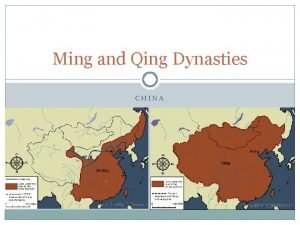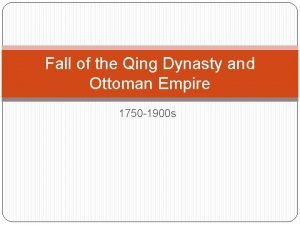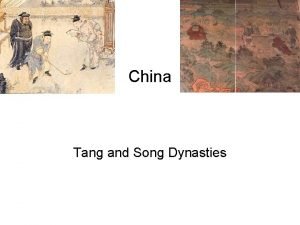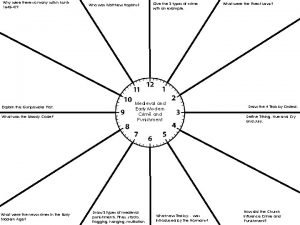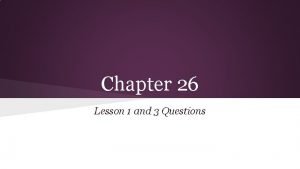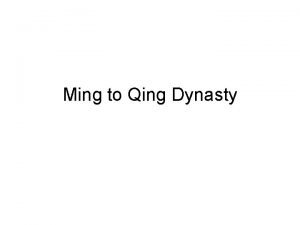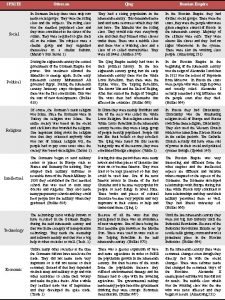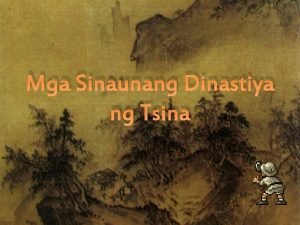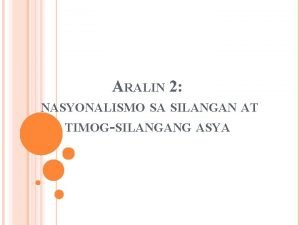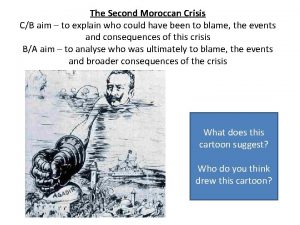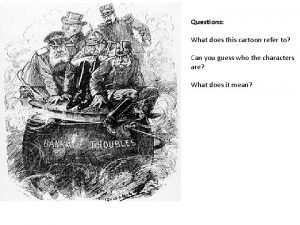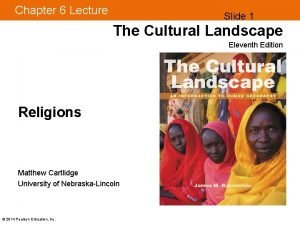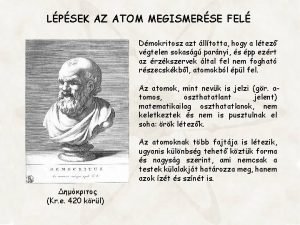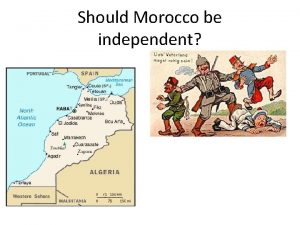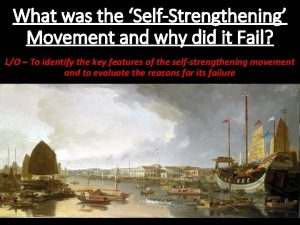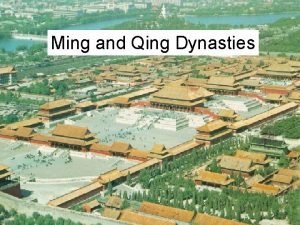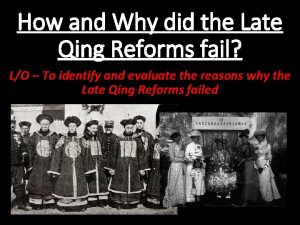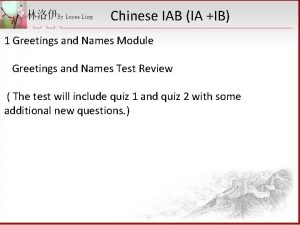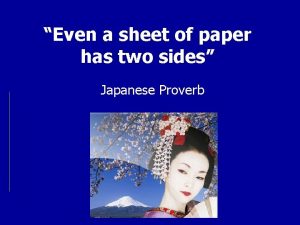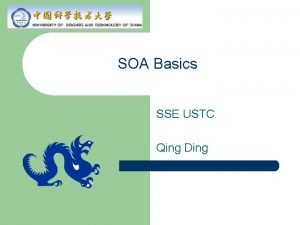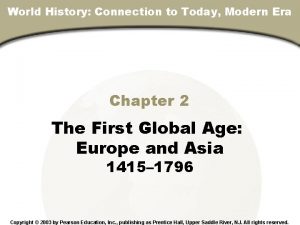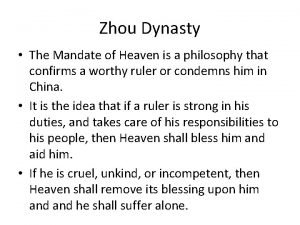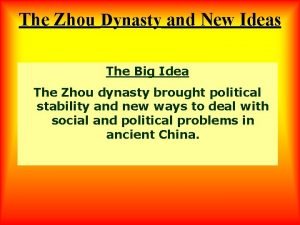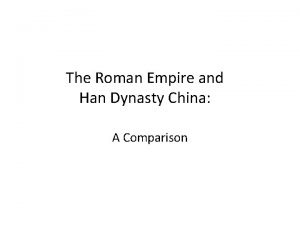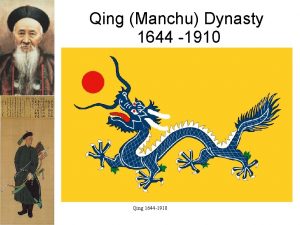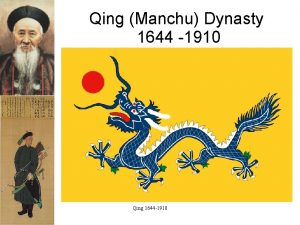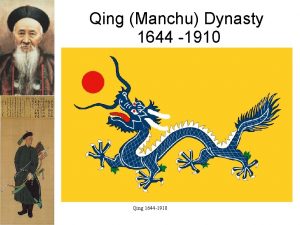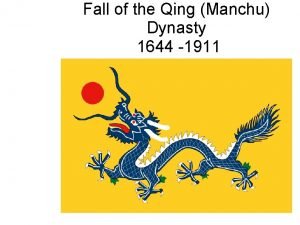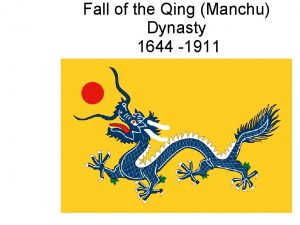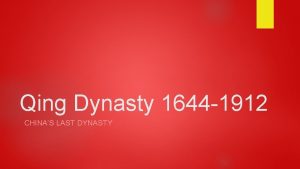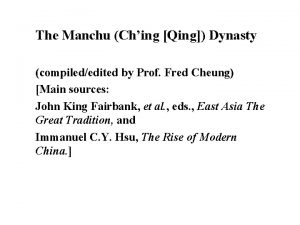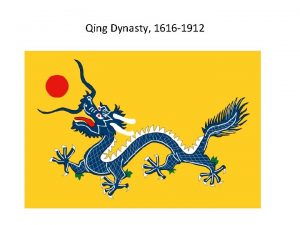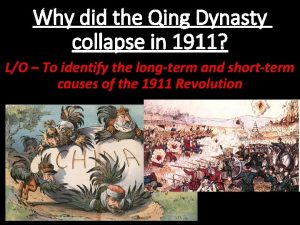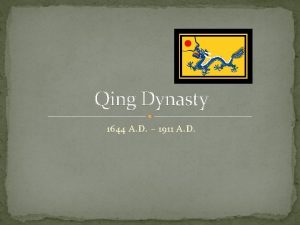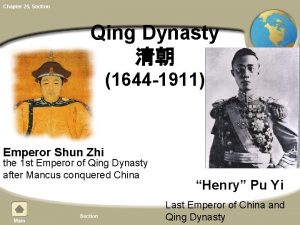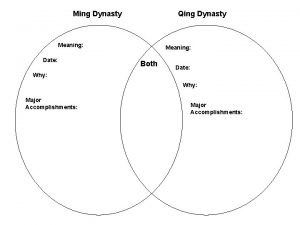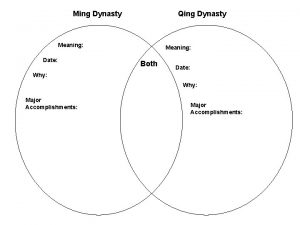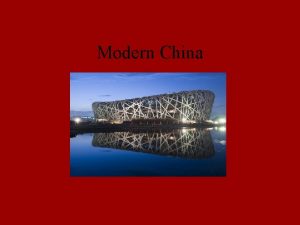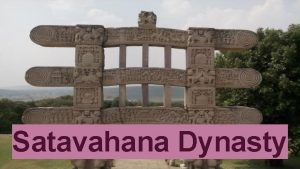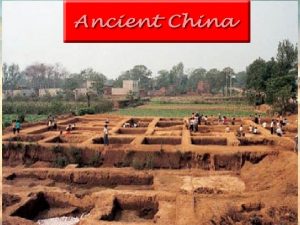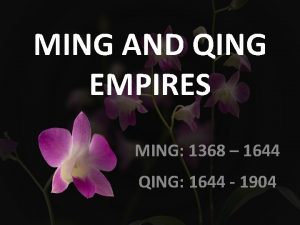The Manchu and the Qing Dynasty 1645 1911







































- Slides: 39

The Manchu and the Qing Dynasty (1645 -1911) n n n 2021/9/6 Barfield, Thomas, The Perilous Frontier, ” Ch. 7, "Steppe Wolves and Forest Tigers, " pp. 250 -294; n OR Pamela Crossley, “Thinking about Ethnicity in Early Modern China, ” Late Imperial China 11. 1 (1990); n OR Rawski, Evelyn S. , “Imperial Women” in The Last Emperors, pp. 127 -159 1

The Manchu and the Qing Dynasty (1645 -1911) n n n Introduction The Rise of the Manchu The establishment of the Qing The Qing Dynasty Succession Marriage Patterns Recruitment of Palace Women Imperial Women Manchu impact on Chinese women The End of the Qing 2021/9/6 2

Introduction The Ming rulers were always very nervous about the possible return of the Mongol were fighting them and so used a less aggressive policy against the Jurchen. n The Ming tried to pacify them by giving them honorary titles and trade agreements but not to all of their demands. n They tried to keep the Jurchen divided by supporting different tribes against each other. n The Ming dynasty (1368 – 1644 ) had to collect higher taxes to finance its wars against the Mongol and so faced rebellions. n There were peasant rebellions that they could not control. n The Jurchen, who had ruled China under the dynastic 3 2021/9/6 name of Jin (Gold)金 Gold (1122 -1234 ), took this n

Introduction (2) n Li Zicheng 李自成 , the leader of the most powerful Chinese rebel armies entered Beijing and declared a new Shun 顺 dynasty (April to May, 1644). n He then led an army of 60, 000 to confront Wu Sangui 吳三桂; the general guarding the mountain pass, Shanhaiguan (山海關). n Wu, caught between Li and the Manchu, decided to ally with the Manchu and led the Manchu into China. n Wu was first rewarded by the Manchu but later revolted against them and tried to establish his own dynasty but died the same year. (The last Ming loyalists battled for another seventeen years. ) 2021/9/6 4

The rise of the Manchu n n 2021/9/6 The Jurchen lived in today’s Helongjiang and Jilin. They began to use the name Manchu after Nurhaci, founder of the Manchu state, f努爾哈赤 (1559 -1626), formally adopted the name Manchu (1635) for the territory under his rule. n It is possible that the using the name Manchu, instead of Jurchen, dated back to 1605 which is why Nurhaci took the name of Manchu when he established the state. n Nurhaci’s son and successor, Huang Taiji 皇太極 (r. 16261643), forbade the people to call 5

The rise of the Manchu (2) n 2021/9/6 Nurhaci was the son of a noble family in present-day North Korea. n He had been a hostage in the household of the Ming general – in charge of peace and relations with the Jurchen – and was educated in the Confucian classics. n When young, he traveled to Beijing to pay homage to the Ming rulers, to trade, and to receive honorary titles in return for helping them against the Japanese in Korea. 6

The Rise of Manchu (3) n Early Manchu history, under Nurhaci, can be divided into: n Tribal phase – n Ends in 1619 when he tried to control and unite the tribes using traditional methods such as marriage alliances and the Chinese tributary system. n Border conquest phase – n Ends at his death (1626) when he was continuing to unite the tribes and, at the same time, incorporate Chinese territory. 2021/9/6 7

The Rise of the Manchu (4) n n In 1609, Nurhaci broke off from the Ming dynasty claiming that the Ming had attacked and humiliated members of his family and had tried to wreck his economic base. n During the next 10 years, he increased his power by dominating neighboring Jurchen and Mongol tribes or by allying with them through marriage. He established a two-tier government: n Separate quarters for Jurchen were set up in towns. n The Chinese were treated as servants. n Jurchen were required to have weapons but Chinese and Mongol were forbidden to do so. 2021/9/6 8

The Rise of the Manchu (5) n n n In 1616, Nurhaci declared himself the ruler of a second Jin (Gold) dynasty – descendants of the Jurchen rulers. He had organized his troops and their families into 8 banners -large civil-military units that replaced the former hunting groups. The banners became administrative units for registration, conscription, and taxation. n n 2021/9/6 Qing Flag: 1862 -1890 Qing Flag: 1890 -1911/12 9

The Establishment of the Qing n n 2021/9/6 Huang Taiji (r. 1626 -1643), succeeded Nurhaci, and declared a Qing dynasty. He centralized power and diluted the power of the tribal leadership by: n Making the tribes subordinate to the dynasty. n Removing senior leaders of the banners. n Reducing banner autonomy. n Creating additional banners (3 Mongolian banners and 1 Chinese) and attaching them to directly to the Central Government. n Increasing the number and authority of 10 the Chinese bureaucracy.

The Establishment of the Qing (3) n Huang Taiji consolidated the empire and laid the groundwork for the conquest of the Ming. n As emperor of the Manchu state, he continued the expansion of Manchuria, pushing deeper into Mongolia and raiding Korea and Ming China. n He added another 8 Mongol and 8 Chinese banners (for those who came over to the Manchu, in, or before 1644). n The eventual conquest of China was achieved by these 24 banners in which less than 16% of the soldiers were of Manchu origin (1648). 2021/9/6 11

The Qing Dynasty is considered the most successful of all conquest dynasties. n Its boundaries are those of today’s China. n The conquest of the Ming was won by a multi-ethnic force so it was important to bind them to the Qing government. n Early Qing rulers claimed both Manchu and Mongol descent by intermarriage with the Mongol -- especially with the descendants of Genghis Khan. n They organized the tribes in southern Mongolia and incorporated them into the banner system. n The old tribes became the new banners and established Mongol leaders received positions of rank in the Qing administration , leading their own 12 2021/9/6 n

Qing Dynasty (2) n n Qing rulers focused on preserving their lineage and culture but also promoted the cultures of the many different peoples they ruled. n Most Qing rulers were multilingual; they studied Mongolian, Manchu and Chinese. Some even learned Tibetan and Uighur. n Like all non-Han rulers, they incorporated Han-type bureaucracies but at the same time they changed the Chinese model to suit their own circumstances. n They concentrated on controlling an empire with different races across Inner and East Asia. n Different laws applied to different peoples and officials were recruited from different groups. All ethnic groups resisted Sinicization and developed their own written languages. 2021/9/6 13

Qing Dynasty (3) As a non-Han dynasty, Qing adopted ideas of ruler-ship from the cultures of their subject peoples. n The Qing emperor was also referred to as the “Great Khan”. n He was identified as the ruler of five peoples – Manchu, Mongol, Tibetans, Uyghurs and Chinese. n These five languages were accepted as the official languages. n Qing’s success, in empire building, was due to its ability to understand the different cultures and peoples within its empire and to administer them appropriately. n While they tried to be fair, they always gave special privileges to the banner nobles and imperial kinsmen who formed boards that were above the Han Chinese 14 2021/9/6 bureaucracy. n

Qing Dynasty (4) n n The Qing tried to change Han society: n They required the people to adopt a Manchu hairstyle. n They passed a law forbidding the footbinding of women –the law was repealed three years later as it was not effective. n Manchu women were forbidden to have their feet bound. The Qing embraced many Chinese elements: n Manchu marriage practices were changed from levirate to serial monogamy with concubinage. n Funeral practices were changed from cremation to burial. n Filial piety was raised to new heights. 2021/9/6 15

Succession The succession issue was first raised in 1622 when Nurhaci’s sons asked their father whom he had chosen to succeed him. n Nurhaci said: n Naming a successor would give that person added power which he might abuse. n The eight banner lords should select the best leader among themselves. n Authority should be shared by the four senior banner leaders – his three sons and his nephew. n When Nurhaci died in 1626, the immediate danger was that if they followed his suggested system there was a possibility of a division of the empire with each banner 16 2021/9/6 leader becoming an independent ruler. n

Succession (2) Nurhaci’s will provided that each of his three sons by Abaha – his third empress — Dorgon, Dodo, and Aige — receive a banner; it was also rumored that he had named Dodo as heir. n The older sons were afraid that the three sons of the Empress, together with the mother, would dominate the government. n They forced the Empress to commit suicide and be buried with Nurhaci and gave banners only to Dorgon and Dodo. n The youngest son, Aige, was denied a banner because of his youth. n During the struggles over succession, the eighth son, Huang Taiji seized authority. 2021/9/6 n Huang Taiji took Aige’s banner for himself, then asked 17 n

Succession (3) Huang Taiji’s death started another succession crisis. n Banner nobles and officials met to elect his successor. n The large number of Nurhaci’s sons made fraternal/lateral succession a possibility. n Huang Taiji’s eldest son, Hooge 豪格; 1609 -1648), was a major contender against his uncle, Dorgon 多爾袞 (161250) , 14 th son of Nurhaci and brother of Huang Taiji. n Dorgon was a great military leader and was supported by a number of banner leaders, but Hooge was also supported by Chinese officials who recognized lineal succession. n The struggle was along banner lines but both candidates had equal numbers of banners. n Rival claims split the Manchu elite. 18 2021/9/6 n

Succession (4) A compromise was reached in which the 5 -year old son of Huang Taiji, Fulin (Emperor Shunzi 順治: 1643 -1661), instead of the eldest, was named emperor with Dorgon as a co-regent. n Dorgon consolidated his personal power and removed his co-regent in 1647 on charges of usurping imperial prerogatives. n He ruled from 1644 until his death on a hunting trip (1650). n It was rumored that he married the mother of Shunzi, Empress Dowager Xiaozhuang 孝莊文皇后 (16131688). n She was of the lineage of Genghis Khan. 19 2021/9/6 n The emperor disliked Dorgon and stripped him of his n

Succession (5) n n n Shunzhi died of smallpox in his twenties but had designated as heir, a younger son, Kangxi 康熙, (r. 16611722), as the young boy already had smallpox. n The designation of an heir broke with the tradition of election. Shunzhi had selected four regents as Kangxi was not yet seven so power was in the hands of the Grand Empress Dowager Xiaozhuang 孝莊文皇后 and the four regents. None of the regents were members of the imperial lineage: n One died soon after his granddaughter was made empress; n Two fought with each other. 2021/9/6 20

Succession (6) The fourth regent, Oboi, soon took over and became as powerful as Dorgon used to be. n Instead of centralizing power under the emperor, Oboi tried to preserve and increase the powers of the Manchu banner elite under the pretense of returning to traditional Manchu customs. In 1669, with the help of his grandmother (the Grand Empress Dowager Xiao Zhuangwen 孝莊文皇后) Kangxi was able to arrest Oboi, and take control. Kangxi is known as one of the greatest emperors in Chinese history; his reign of 61 years makes him the longest-reigning Emperor of China. n n n 2021/9/6 21

Succession (7) The Kangxi emperor installed his first son by the Empress as heir but found him unfit for office and demoted him. n A fierce power struggle began among the other sons for the position and Kangxi said, “at my deathbed some of you will fight each other for the throne, swinging your swords over my corpse!” n After Kangxi’s death, the fourth son announced that he was his father’s dying choice and declared himself emperor, Yongzheng. n He then arrested those brothers whom he suspected would not support him. n As emperor, he announced that he would put the name 22 2021/9/6 n

Succession (8) Of the 11 Manchu emperors who ruled from 1644 to 1911 only one (the Daoguang 道光 emperor, son of Jiaqing 嘉慶 emperor) was the son of an empress. n The birth mothers of emperors Yongzheng 雍正 , Qianlong 乾隆 , Jiaqing 嘉慶 came from lowly servant backgrounds. n The rejection of the eldest-son succession principle, and the secret naming of the heir to be announced after the emperor’s death resulted in fierce succession struggles. n The contest for succession divided brother from brother, with the victor exterminating his rivals. n Although the emperor could only have one empress at a time, there would be a number of empress dowagers as the first act of an emperor was to name his birth mother as empress dowager. 23 2021/9/6 n

Marriage Patterns Manchu marriages with Mongol nobles increased as the Qing armies expanded into central Asia in the late 17 C and early 18 C. n 25% of empresses, 16% of princes’ wives, and 55% of princesses’ spouses were Mongol. n Empresses and principal wives of princes and husbands of princesses came from a small number of favored houses. n Of the 641 Manchu clans, only 31 were favored with marriage. n The number of empresses and concubines, important enough to have biographies, ranged from Kangxi with 40 to Guangxu with only 3 – 24 2021/9/6 n

Marriage Patterns (2) n For political purposes, the early Manchu emperors took wives descended from the descendants of Genghis Khan, so that their descendants would also be seen as legitimate heirs of the Mongolian Yuan dynasty. n The imperial family only married with banner families. n All Manchu, not only the imperial family, were forbidden to marry Han Chinese who were not in the Eight Banners. n Any who disobeyed this rule would be punished and their offsprings expelled from the lineage. n Han Chinese, not in the banners, could be taken in as concubines. 2021/9/6 25

Recruitment of Palace Women Recruitment of women into the palace was done every three years through drafting of daughters of officials in the banners. n Except for certain individuals, every girl, between the ages of 13 to 14 sui. had to appear in Beijing for consideration before her marriage. n After 1653, young girls between 13 -14 had to be presented to the palace in Beijing before they could be betrothed. n Those who caught the emperor’s eye would be selected for the harem. n Some were be chosen to be wives for the princes, others served in the palace for a five-year term. n Palace maids selected through a separate draft could 26 2021/9/6 n

Imperial Women n The influence of imperial women was feared by the Manchu. n In the struggle for power, Nurhaci’s senior widow, Abahai, was forced to commit suicide and was buried with her husband. n Huang Taiji might have been acceptable as his mother had died by the time he became the leader of the Manchu and there would be no strong maternal influence during his rule. n The mother of Yongzhen emperor was separated from her son soon after his birth, so Yongzhen was raised by another imperial woman (d. 1689) who was of noble ancestry and whose only daughter had died. 2021/9/6 27

Imperial Women (2) To prevent palace women and their families from power, palace regulations made it almost impossible for an imperial consort to remain close to her natal kin. n Visits home were rare and demanded that her parents and grandparents kneel before her. n Imperial permission was needed for meetings with parents – when a woman was pregnant or when her parents were elderly. n Special permission was needed for them to send servants to their family homes as messengers. n They were forbidden to give or receive gifts from family members. n Motherhood usually brought promotion to the woman but the title of Empress Dowager was usually conferred upon 28 2021/9/6 her by her son should he become emperor. n

Imperial Women (3) n The women who survived the power struggles became very influential: n After the death of Huang Taiji (1643), the mother of the infant (Fulin: Shunzi), who was descended from Genghis khan became very important. n She allied herself with prominent Manchu nobles who were not imperial kinsmen but had been active in the conquest. n She brought up her grandson, the future Kangxi emperor, and helped him get rid of the regent, Oboi, and rule in his own right. n Her political role during her son’s infancy and the regency of her grandson could be compared with that of Empress Dowager Cixi who dominated the last 50 years of the dynasty. 2021/9/6 29

Imperial Women (4) Two regents, Cian (1837 -1881) and Cixi (1835 -1908), dominated the final years of the Qing and ruled together after the death of Emperor Xianfeng together with the emperor’s half-brothers. n Cian was the daughter of a Duke and was the empress of Xianfeng emperor (r. 1850 -1861). n She became a regent as she was the former empress. n She had been named empress at the age of 16. n She had no sons and so the 6 year-old son of a concubine (Cixi) succeeded to the throne as Emperor Tongzhi (1856 -1875). n Cixci, Xianfeng’s concubine, became regent as she was the biological mother of empeor Tongzhi. n As Empress Dowager, Cixi was de facto ruler 30 2021/9/6 n

Manchu Women n Manchu women had greater freedom and authority. n They were forbidden to bind their feet and walked in public places, rode horses, practiced archery and participated in hunts. n Princess Hexiao — the youngest daughter of Qianlong — dressed in man’s clothing, practiced archery and accompanied her father on hunts. n The emperor was recorded as saying that if she had been a boy he would have made her the heir. Women were occasionally active on the battlefield: a few were even named banner lieutenant during the conquest. n They held key roles in religious services at court. Manchu and Mongol nobles of both sexes had the right to divorce. 2021/9/6 31

Manchu Impact on Chinese Women n n The Manchu tried but was not able to stop footbinding in the early Qing. The lecture on Mongolorization of women showed that the Manchu reduced the number and pattern of widow suicide. n During the Qing, prostitution was abolished and all sex work were considered criminal acts. n All

Manchu Impact on Chinese Women: Prostitution n For centuries the state managed sex workers. n The sex service was a form of slavery like that of comfort women during the Second World War. In the Han dynasty, the wives and daughters of some criminals were sentenced to serve in state-managed military brothels. n Their status would be passed on to their descendants – hereditary prostitution. Beginning with the Sui dynasty (580 -618 ), state managed sex workers were referred to as yue ren 樂人 (singers, dancers, maids, etc. ) and worked within yue hu 樂戶 – music households. 33

Manchu Impact on Chinese Women: Prostitution (2) n n The practice of sentencing wives and daughters to prostitution continued from the Tang through the Ming. n In some periods of history, prisoners of war and their families were similarly sentenced. Under Ming law, there were two kinds of prostitution – the one supervised by the state and private unofficial ones that were regarded as unlawful. n The private ones were: n Widows, discarded concubines, and divorced women who had to survive by becoming prostitutes under the pretense of being Daoist and Buddhist nuns. n The wives or daughters of poor men to help earn money for the family. 34

Manchu Impact on Chinese Women: Prostitution (3) n n Yuan law prohibited commoner males from forcing a wife, concubine, adopted daughter or a domestic slave to be a prostitute. n The man was also prohibited from forcing a wife concubine or adopted daughter to sing and dance to entertain others. In the Ming, the emperor periodically announced amnesties to release descendants of political prisoners from their status. Emperor Yongzheng of the Qing abolished the yue hu households and made them commoners in 1723. n All former sex workers were held to the same standard of chastity as the commoners. n Prostitutes, their pimps (often their husbands), and those who used their services all became criminals. n All sex work became criminal acts. 35 The result was the complete prohibition of prostitution.

The End of the Qing n n The two Opium wars with the West (1839 -1842) (18561860), the internal rebellions such as the Taiping 太平 Rebellion (1851 -1864) and the Boxer Uprising from (1899 -1901) made the Qing weak politically and economically. n By 1908, both Cixi and Emperor Guangxu died leaving a powerless and unstable central authority. Puyi was named emperor at the age of two the day before the deaths of Cixi and Guangxu. n His father was regent and ruled together with an "Imperial Family Cabinet” – a ruling council of the Imperial Government almost entirely consisting of relatives of Puyi’s lineage. 2021/9/6 36

The End of the Qing (2) n n n With permission from Empress Dowager Longyu (wife of Emperor Gungxu and niece of ED Cixi), negotiations were held with the rebels led by Sun Yatsen. n Empress Dowager Longyu issued the edict abdicating the child emperor Puyi. In 1931, the Japanese created a puppet state named Manchuguo with Puyi as emperor. n By this time Manchuria was overwhelmingly Han Chinese, and even among the Manchu, this project failed to generate much genuine interest. Manchuguo was abolished at the end of World War II and the land was given back to China. 2021/9/6 37

The End of the Qing (3) The reasons for the decline and fall of the Qing were different from those that brought down the earlier dynasties. n Externally, Qing China was drawn into modern world politics by the West whose culture was in many ways equal to hers and whose technology was superior. n Internally, the population explosion created social and economic problems which the Qing was unable to cope. n The feeling of nationalism and the development of a “Han identity” by the majority population, influenced by western thought made it impossible to accept a foreign conquest dynasty – Manchu -- to rule China. 38 2021/9/6 n

The End of the Qing (4) The reformists had tried to establish a constitutional monarchy like that in Japan and in England. n When this effort failed and Guangxu was imprisoned by Cixi they gave up the idea and decided to form a new nation. n The new communists and nationalists believed that China was backward because of feudalism – the oppression of men and women by Confucian practices, especially that of women through footbinding and the lack of education. n The liberation of women, therefore, became part of the liberation of society from feudal practices. n The women’s movement, therefore, had to be supported by all regardless if they were communists or nationalists. 39 2021/9/6 n
 Qing ting
Qing ting Ming and qing dynasty
Ming and qing dynasty Ming empire
Ming empire The fall of the qing dynasty
The fall of the qing dynasty Tang vs song dynasty venn diagram
Tang vs song dynasty venn diagram Why were there so many witch hunts 1645-47
Why were there so many witch hunts 1645-47 Qing dynasty decline
Qing dynasty decline Chapter 26 lesson 1 the decline of the qing dynasty
Chapter 26 lesson 1 the decline of the qing dynasty Qing dynasty dbq
Qing dynasty dbq Qing empire at its height
Qing empire at its height Qing dynasty social classes
Qing dynasty social classes Dinastiyang manchu
Dinastiyang manchu Namumuno sa rebelyong taiping
Namumuno sa rebelyong taiping 2nd moroccan crisis
2nd moroccan crisis The first cartoons
The first cartoons Modelo atómico de rutherford (1911)
Modelo atómico de rutherford (1911) Niagara falls frozen 1911
Niagara falls frozen 1911 Revelation 1911
Revelation 1911 Ireland 1911
Ireland 1911 Ireland 1911
Ireland 1911 1911 1988
1911 1988 Fila heritage 1911
Fila heritage 1911 Atommodell 1911
Atommodell 1911 Moroccan crisis 1911
Moroccan crisis 1911 Self-strengthening movement
Self-strengthening movement Qing conquest of the ming
Qing conquest of the ming Qing social structure
Qing social structure Late qing reforms
Late qing reforms Ming dynasty social hierarchy
Ming dynasty social hierarchy Qing wen nin gui xing
Qing wen nin gui xing Qing china at its height
Qing china at its height A piece of paper has 6 sides
A piece of paper has 6 sides Qing ding
Qing ding What policy did the qing adopt regarding foreign trade?
What policy did the qing adopt regarding foreign trade? Difference between a dynasty and an empire
Difference between a dynasty and an empire Difference between empire and dynasty
Difference between empire and dynasty What is the mandate of heaven?
What is the mandate of heaven? The zhou dynasty and new ideas
The zhou dynasty and new ideas Empire vs dynasty
Empire vs dynasty Pg 170
Pg 170


